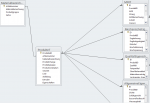Hello all,
I am new to access and don't yet understand the relationships between tables, with that I am having really a had time in making my access program to work.
I hope some of you can have pity on an newbie like me and help me. because I am getting really frustrated here as I cannot continue.:banghead:
because I am getting really frustrated here as I cannot continue.:banghead:
In excel I have a file with one sheet that has many colums which contain different data in one row for one material.
Now the problem is, I don't want the 60+ rows in my access table. Therefore I have broken down the table in many small tables that contain the specific data required. for that one material. The problem I face now is I don't know how to link the many different tables to the main table.
For example when u enter a new material in the main table and then enter new details in the other tables, how do you link the data from all these tables to the new material that we have just entered?
If someone is interested in helping me, I could also provide you with an exemplary excel table and my new access table...
many thanks in advance,
AljayB
I am new to access and don't yet understand the relationships between tables, with that I am having really a had time in making my access program to work.
I hope some of you can have pity on an newbie like me and help me.
In excel I have a file with one sheet that has many colums which contain different data in one row for one material.
Now the problem is, I don't want the 60+ rows in my access table. Therefore I have broken down the table in many small tables that contain the specific data required. for that one material. The problem I face now is I don't know how to link the many different tables to the main table.
For example when u enter a new material in the main table and then enter new details in the other tables, how do you link the data from all these tables to the new material that we have just entered?
If someone is interested in helping me, I could also provide you with an exemplary excel table and my new access table...
many thanks in advance,
AljayB
Attachments
Last edited:


